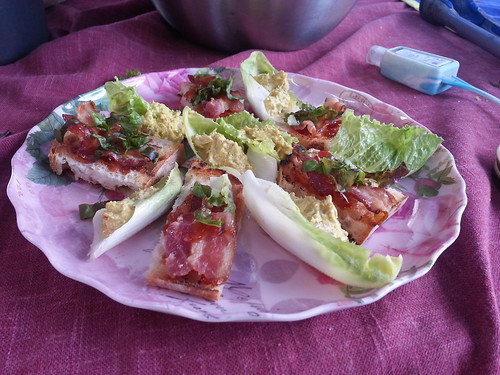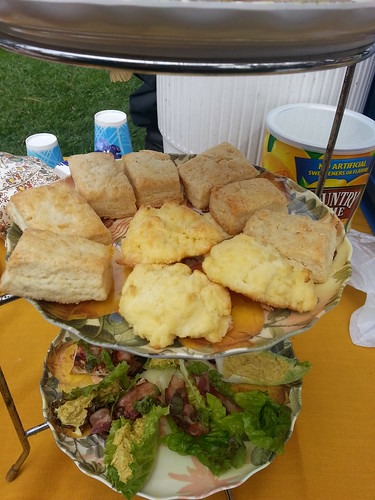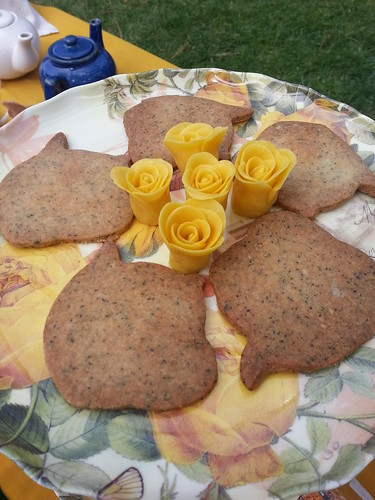If you haven't canned before, you will probably find it easier than you think. It's more logistics than anything. You just need a large pot with some sort of insert to keep your glass from directly contacting the hot bottom. The jars are kept submerged in simmering water to stay sterile until you need them, and the same with the lid rings and seals in a separate pot. When it is time to actually fill the jars, having done your mise en place is really important. That includes having a tool to lift out the jars. I have a magnet on the end of a long plastic rod which is really useful for retrieving seals and lids.
To can something, you pull out a hot jar, dumping the water back into the pot. Fill the jar, leaving adequate airspace at the top (this will vary by the size of the jar, and what you are canning. Clean the rim, and place a seal on top. Screw a ring on, just tight enough to keep the seal in place. The seal needs to be able to allow air bubbles to escape. The sealed jars are returned to the water, and completely submerged. They need to sit in the boiling water for a length of time, which will again vary by the size of the jar and what is in it.
A classmate had given me three large, ripe white grapefruit, so I decided to make marmalade out of them. The recipe I adapted is this one from about.com. I peeled the grapefruit with a sharp vegetable peeler, then went back over the peel with a sharp knife, to eliminate any remaining white pith. I then cut the peels into a fine julienne. I then peeled the remaining pith off the grapefruit, and carefully cut out supremes from the inner membranes. I did squeeze out as much juice as possible from the remaining core.
The cores were wrapped in cheesecloth, and cooked with everything else to help add pectin for jelling. I didn't trust it to jell naturally, however, so added a pouch of liquid pectin. The juice, segments, and zest are cooked with a little water and a whole lot of sugar until it reaches 220 F. It takes a while to get there, a lot of water has to evaporate to allow it to get to that temperature.
Once it got to the required temperature, I added the liquid pectin, and cooked it further. Finally, the cheesecloth bag was removed, and squeezed to get out as much marmalade as possible. The result was canned.
It turned out having a very strong grapefruit taste. Despite the huge amount of sugar, it retains a lot of the grapefruit bitterness. You may need to be a grapefruit fan to like this.
I had a lot of oranges left over from the SCA lunch we did last weekend. I thought was a good idea to use alt east some of them for orange marmalade. All the orange marmalade recipes I found included lemons. I adapted this one from Sure Jell. It had me cook the fruit with the pectin first, then add the sugar. I realize now that the recipe expects powdered pectin, not liquid. It worked, so no complaints. I think next time I'll do it the same as the above recipe.
I did the same with the peels as above. I removed them from the fruit, cleaned them up with a sharp knife, and julienned them. I sectioned the fruit the same way.
The peels were simmered with a little baking soda in water for a bit, then the fruit and juice added. This was simmered some more, Then measured out. The recipe wants exactly 4 cups of fruit and peel mixture. Luckily for me, that is exactly what I had.
The mixture is brought to a boil, have the pectin added, then brought back to a boil. The sugar is added, and it is once again brought back to a boil. It is cooked for one minute, then removed from the heat, and canned.
It has a nice orange flavor, and the lemons help give it a bit of sharpness.
One trick I figured out with the marmalades. If you do not want all the peel to end up at the top of the jar, while the jars are cooling and the jell is setting, every five or ten minutes give the jars a good shake. As it gets thicker, it gets harder for all the peel to float to the top.
After Thanksgiving, we had a very nice pumpkin that we cut up and froze the meat. We wanted to do something with it. However, the National Center for Home Food Preservation (of course there is a National Center for Home Food Preservation) does not recommend canning pumpkin butter. Pumpkin butter is too low acid to be safely canned using the water bath method.
Chutneys, however, are a pickled product. All the added vinegar makes it more than acidic enough to can. I started with this recipe, but replaced the dried cranberries with fresh, added currants, and used date molasses rather than maple syrup.
I caramelized sliced onion in olive oil, then added the pumpkin, cranberries, currants, minced Serrano chili, molasses, date molasses, cinnamon sticks, whole cloves, minced ginger, apple cider vinegar, balsamic vinegar, salt, and a little water. This was allowed to simmer for forty five minutes, until thick, and the pumpkin and cranberries tender.
This was then canned.
It is a really nice sweet, spicy, vinegary mix. I could just eat a bowl with a spoon. Will make a great butter for scones.
Recipes
Grapefruit Marmalade
3 large, ripe white grapefruit
7 cups sugar
1 pouch liquid pectin
4 cups water
Use a vegetable peeler to remove skin. Use a sharp knife to remove any remaining white pith on the zest. Cut the strips of peel into a fine julienne.
Remove remaining pith from the fruit, and cut out the sections of fruit without taking any inner membrane. squeeze out any juice from the remaining cores. Wrap cores in cheesecloth, and tie securely.
Place peel, fruit, juice, water, and sugar in a large pot over medium heat. Once it comes to a simmer and the sugar is dissolved, add the cheesecloth with the cores.
Allow to simmer until mixture reaches 220 F. Add in pectin. bring back to a simmer, cook for seven minutes. Remove cheesecloth bag, squeezing out as much liquid as possible. Remove pot from heat, allow to stand for five minutes. Ladle into jars, seal and process in a water bath for ten minutes.
Makes 7 half pint jars.
Orange Marmalade
4 large navel oranges
4 small lemons
2 1/2 cups water
1/8 tsp. baking soda
1 pouch liquid pectin
5 1/2 cups sugar
Use a vegetable peeler to remove skin. Use a sharp knife to remove any remaining white pith on the zest. Cut the strips of peel into a fine julienne.
Remove remaining pith from the fruit, and cut out the sections of fruit without taking any inner membrane. squeeze out any juice from the remaining cores.
Place peels, water, and baking soda in a pan over medium heat. Bring to a simmer, cook 20 minutes. Add fruit and juice, bring back to a simmer, cook another ten minutes.
Transfer mixture to a large pot. Bring to a full boil, add pectin. Bring back to a boil. Add sugar. Bring back to a boil, cook for one minute, stirring constantly.
Remove from heat. Ladle into jars, process in a water bath for 10 minutes.
Pumpkin Cranberry Chutney
1 onion, cut into thin slices
2 Tbsp. olive oil
1 1/2 lbs. fresh or fresh frozen pumpkin, cut into 1/2" cubes
4 oz. fresh or fresh frozen cranberries, rough chopped
4 oz. currants
2 cups apple cider vinegar
1/2 cup water
1/2 cup date molasses
1/4 cup molasses
2 Tbsp. balsamic vinegar
1 Serrano chili, minced
2 Tbsp. fresh ginger, minced
2 cinnamon sticks
6 whole cloves
1 Tbsp. kosher salt
2 Tbsp. yellow mustard seeds
In a large pot over medium high heat, add olive oil. Add onion, cook until caramelized. Add the rest of the ingredients. Bring to a simmer, cook for 45 minutes, stirring occasionally.
When mixture is thickened, and pumpkin and cranberries are tender, ladle into jars. Process in a water bath for 15 minutes.
Happy Eating!























